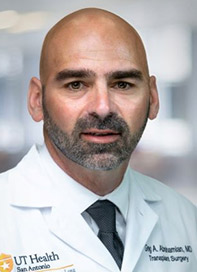Make a difference in the life of a person who needs a liver transplant at University Health by becoming a living liver donor.
What Is Living Liver Donation?
Living liver donation is when a person donates a portion of their liver to someone in need of a liver transplant. This allows patients to get a new liver before their condition gets worse. Due to a shortage of deceased liver donors, living donation is the quickest way for your family member or friend to get a liver transplant.
Liver Donation Facts
Be aware of these important facts if you’re considering living liver donation:
- The liver is the second most-commonly transplanted organ.
- You can safely donate up to 70% of your liver because your liver can regenerate and fully support your body’s needs in a very short period of time.
- The liver does not necessarily go back to full size; it just increases to meet the demands of the body. Most of the time this is about 80% of its original size.
- According to the U.S. government's organ donation statistics, nearly 7,400 people became living organ donors in 2019.
Second Largest Living Liver Donation Program in the United States
University Health Transplant Institute has performed over 300 living-donor liver transplants since we started in 1999. Our Institute performed the first liver paired donation in the United States.
Why You Should Donate
The wait for a liver transplant can be long. During the wait, some people’s liver failure gets worse. Some die waiting for a liver transplant. Living donation shortens wait times and improves the quality of life for patients with liver failure.
Who Can Be a Living Liver Donor?
Living liver donors must:
- Be between the ages of 18 and 55 years old
- Go through an evaluation and testing process
- Have a stable living situation with family or social support
- Be in excellent health with no chronic health conditions
- Understand the risks and possible complications of liver donation
- Have a healthy weight
Types of Living Donations
You do not have to be a blood relative to be a compatible match with a recipient. Many friends, distant relatives, co-workers and even strangers have become living donors to those in need of a liver transplant. Common types of living liver donations include:
- Direct – You name the specific person to receive a part of your liver for transplant, usually a family member or close friend
- Paired– You give part of your liver to a compatible recipient, and your chosen recipient gets a compatible donation from another person
- Nondirect – You donate part of your liver to an unknown compatible recipient that needs a transplant
Becoming a Living Donor
Count on the transplant team at University Health to make sure it’s safe for you to become a donor. Your first step is to complete and submit the living liver donor health history questionnaire.
Expect a screening call and several evaluation steps to learn whether you can donate a part of your liver. Your recipient covers the cost of your tests and surgery. Your evaluation may take a few weeks to complete.
Your Living Donor Coordinator
Make an informed decision about living liver donation with help from the knowledgeable living donor coordinator at University Health Transplant Institute. Your coordinator will help ensure you have the information you need.
Individualized Donor Support
If you need more information about living donation, ask your coordinator to set up one-on-one meetings for you with:
- Previous living donor
- Transplant social worker
- Transplant surgeon
You have the right to change your mind or decline donation at any time during the process. We protect your privacy regardless of your decision.
Your Guide to Making an Informed Decision
Learn detailed information about becoming a living liver donor by viewing our comprehensive booklet:
Find out more about:
- How to begin the donor process
- Donor evaluation and testing
- Surgery to remove part of your liver
- Recovery time
- Risks and possible complications
- Life after donation
- Benefits for donors
High-Quality Care and Patient Outcomes
Review our transplant quality and recognition information that shows our program provides high-quality care. Our Scientific Registry of Transplant Recipients (SRTR) data and reports show we meet or exceed the national expectations for patient survival. That means we have outstanding patient outcomes for a liver transplant.



